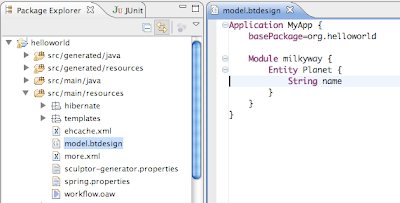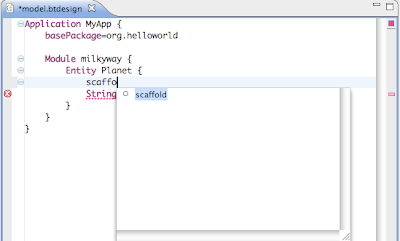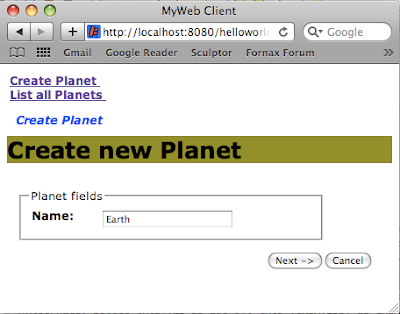This article illustrates the first basic steps of how to use Sculptor. We will create a simple hello world application. It will only have one simple domain object and some CRUD operations.
Alternative video format (mpg)
We start by firing off some maven archetype commands to create the business and presentation tier projects. The sculptor archetypes creates maven pom files with needed dependencies. We generate eclipse projects from those maven projects using the ordinary maven-eclipse-plugin. These projects are imported into Eclipse. You find the commands for this in the
wiki.
We open the design model that is the input to the code generator. It is a textual DSL that defines the application structure. We define the Planet Entity in a Module.

We also need some CRUD operations to be able to do something with the Planet in the to be generated GUI. It is easiest to add those with the scaffold keyword. Note that the DSL editor has support for code completion, error highlight and outline view (including ctrl+O).

Now it is time to generate code, but first we will turn off one feature. Sculptor promotes writing junit tests, but for this demo we turn off that by adding a property to sculptor-generator.properties.
generate.test=false
We build the application by executing mvn install from the -parent project. The code generation is part of the maven build cycle.
We start the web application server by running mvn jetty:run from the -web project. Note that this is also a maven command, and no specific installation of an application server and database is required. Hsqldb inmemory database is used.
The generated CRUD GUI is available at http://localhost:8080/helloworld-web/

That was everything needed to create a minimal application. It illustrates how easy it is to get started. Within 15 minutes you can go from scratch to a running application, including build scripts, Eclipse projects, domain model, JPA persistence, services, Web Flow application and much more. Thereafter you can continue by evolving the design, add manual code and regenerate.
This was an extremely simple example. Sculptor can be used for much more advanced applications. The CRUD GUI is useful for administrative sections of the application or to serve as a scaffolding for your manually crafted user interface. The major strength of Sculptor is in the business tier when developing typical enterprise or web applications that benefit from a rich and persistent domain model.










